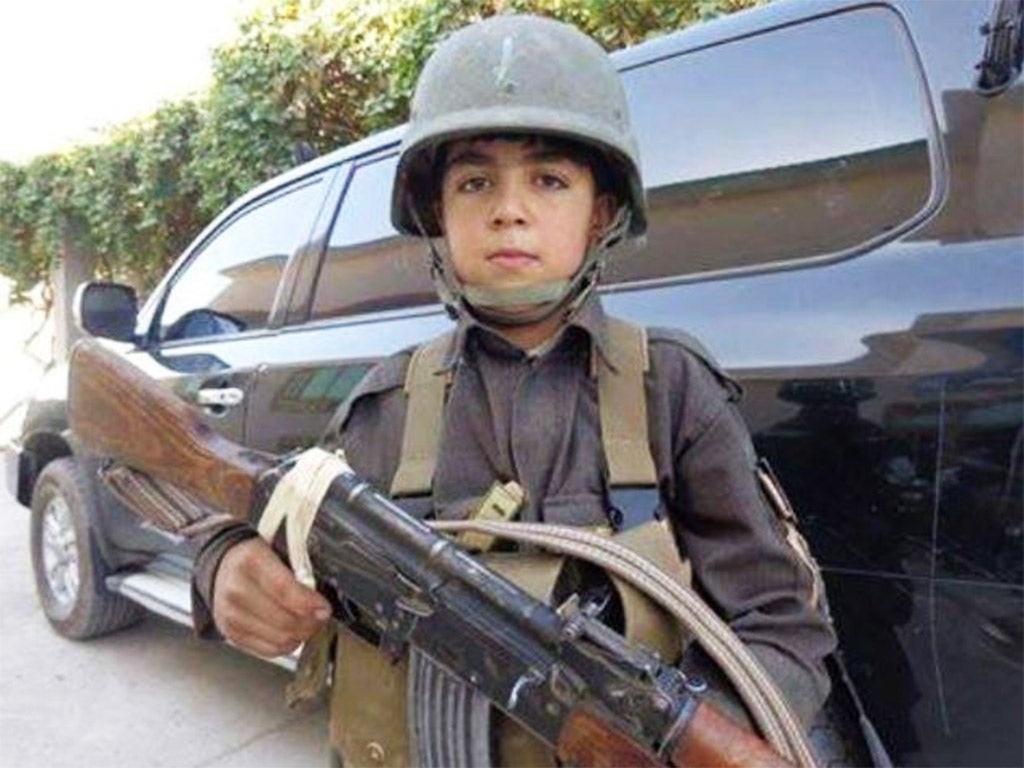Wasil Ahmad: Taliban assassinate Afghanistan's 10-year-old hero of Uruzgan siege
His role firing mortars and machine guns from the roof of a besieged government compound during the 43-day stand-off led to him being feted as a hero by the police militia with whom he fought. But it also made him a target of the Taliban

He played football and cricket, lived with his family in the dusty Afghan town of Tarinkot, and had a tutor to help him learn English. But even in a country torn by war, Wasil Ahmad was no ordinary 10-year-old schoolboy.
His role in a 43-day stand-off with the Taliban in a remote district of Uruzgan province last year, firing mortars and machine guns from the roof of a besieged government compound, led to him being feted as a hero by the police militia with whom he fought, by the provincial government and on social media. A photograph of Wasil carrying an automatic weapon and wearing a police uniform garlanded with plastic flowers went viral across Afghanistan.
But it also made him a target of the Taliban. Early on Monday afternoon, his lessons over for the day, Wasil set off with schoolfriends to the bazaar – where 200 shops and stalls supply the needs of the town’s 70,000 inhabitants – to fetch some apples.
Then two shots rang out. “I saw two men on a motorbike and suddenly we saw him fall,” his classmate Haroon Shah, who was with him, told The Independent. “The apples he bought were covered with blood. After the first shot he was just saying, ‘I’ve been hit.’ Then the second bullet hit him in the head and he fell to the ground.”
Wasil’s uncle, Abdul Samad Khan, said: “Two men on a motorbike used a pistol and shot him in the head and on his waist. We took him to Kandahar. He was fighting for his life all along, he had lost a lot of blood. He died in a hospital in Kandahar city.”
If there was any doubt about who was behind Wasil’s murder, it did not last for long. On Monday, the Taliban announced that it had killed him with two shots.
His death has not only caused dismay among Afghans, it has also provoked a flurry of questions about the continuing role child combatants on both sides in the apparently ceaseless struggle for the country’s future.
The use of child soldiers is illegal in Afghanistan, but the charity Child Soldiers International said both government forces and insurgents have been recruiting minors for years.
The organisation’s policy and advocacy director Charu Lata Hogg said the Afghan government, despite pledging to stop the recruitment and use of children by the Afghan security forces, was making only “slow and tardy progress”.
“There is a lack of political will to address this issue,” she said. “There is a commitment by the government to clean it up, but sufficient measures are not being taken.”
In a report to the UN Security Council’s working group on children and armed conflict last year, the charity said children were recruited by the Afghan National Police and the Afghan Local Police. It said the recruitment was driven mainly by poverty, but also filial duty, patriotism and honour.
The Afghanistan Independent Human Rights Commission blamed Wasil’s death on his family, the government and the Taliban. Its spokesman, Rafiullah Baidar, said police should not have lauded the boy for his role in the Taliban siege, during which his father Hamidullah had been killed in fighting.
“Possibly he took up arms to take revenge for his father’s death, but it was illegal for the police to declare him a hero and reveal his identity, especially to the insurgents,” Mr Baidar said. “One side made him famous and the other side killed him – both sides ignored the law and acted illegally.”
The largely neglected mountainous province into which Wasil was born, connected to Kandahar by a single road that is regularly planted with concealed bombs, has long been a centre of conflict. It is where Mullah Mohammad Omar, the late Taliban leader, was born; and its capital Tarinkot is where, in late 2001, Hamid Karzai led the first Pashtun revolt against the Taliban after 9/11, shortly before he became president of Afghanistan.
In such a volatile area where even girls soon learn how to fire weapons, Wasil was handling guns daily from an early age. His father was a police chief and his uncle, Mr Khan, was the police commander in Khas Uruzgan district when the Taliban laid siege.
He recalled: “[Wasil] was an amazing soldier and a commander. Six months ago when I was injured and we were surrounded for 43 days by Taliban, he took charge of the fighting. He fought against the Taliban for 43 days. He knew how to use heavy machine guns and rocket propelled grenades. He was also an expert in firing mortars: he couldn’t miss.”
Mr Khan, who was later moved with his family, including Ahmad, to the relative safety of Tarinkot, suspects more than one hand was involved in the boy’s killing. “I want the government to investigate this murder,” he said. “I don’t think it was the Taliban alone – it was a murder helped by others also.”
But Wasil had lost his childhood long before he was killed, from the moment he picked up a gun. Haroon Shah said of his slain schoolfriend: “He played soccer and cricket, but he was not like a child. He was more like a grown man – always more serious.”
Additional reporting by Rahim Faiez and Lynne O’Donnell, Associated Press
Join our commenting forum
Join thought-provoking conversations, follow other Independent readers and see their replies
Comments